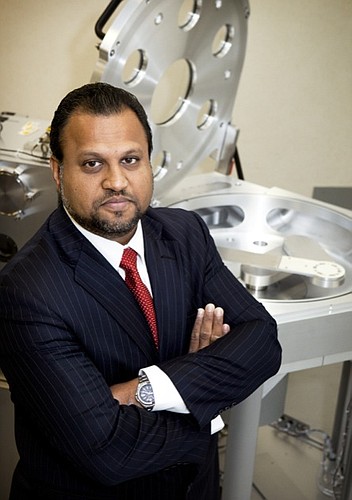- November 26, 2024
-
-
Loading

Loading

Employees constructing machines at St. Petersburg-based Plasma-Therm LLC look more like nurses than manufacturers. The workers wear caps and protective masks while fine-tuning the firm's machines, which will eventually produce microchips 200-square-microns in diameter.
Hence the uniforms. The microprocessors produced by Plasma-Therm's machines are so small that a human-hair-sized defect could render one of the machines, which sell for as much as $6 million, unusable to its customer, who could include one the suppliers of Apple or Nokia. “The human body is the largest source of contaminants,” explains CEO Abdul Lateef.
There have been few mistakes at Plasma-Therm, Lateef says. In fact, he says the company experienced 58% growth in annual revenues in 2011 compared with 2010. And it had a 67% growth in revenues from the previous year. “That's huge,” Lateef exclaims. Lateef declines to disclose Plasma-Therm's revenues as a private company, but in a 2010 article he said the firm averaged about $50 million annually during the previous 10 years. Lateef also says the company employs more than 100 workers, although he would not disclose an exact number.
The machines that come out of the equipment Plasma-Therm produces have amazingly diverse uses. “We play in so many markets that sometimes it's even difficult to see which markets we're in,” Lateef says. Although he does mention chips used in LED lights (to which he attributes the strong growth in 2011) solar panels on orbiting satellites and even in night vision goggles.
But Plasma-Therm has managed steady growth due to its geographical reach as well. Earlier this year the firm purchased Advanced Vacuum, a Swedish firm that performs failure analysis, a process that uses Plasma-Therm's plasma-etching machines to break apart a microprocessor to see why it failed. Lateef says buying Advanced Vacuum was an important vertical acquisition that will bring the firm into more markets.
Sweden is merely a tiny meatball in Plasma-Therm's international dish. The company receives roughly 40% of its revenues from the Asian market, particularly China. “We're one of the few companies trying to reset the trade deficit,” Lateef says with a smile.
However, a large international footprint comes with its problems. Lateef says the United States Department of Commerce's trade policy has been restrictive on how much Plasma-Therm can sell to China. Also, there have been instances in which a Plasma-Therm machine is bought and then reverse-manufactured — copied. Lateef says patent protection has helped, “and we do keep some undocumented secrets close to our chest,” he says.
With tenuous relations with China and an uncertain economic market, Plasma-Therm is at risk in a global recession. Lateef, however, says the company's sales process has an economic forecast built in, and expects growth in 2012 — not as much as in previous years, though.
Also, since the firm must be sensitive to any new technological innovation, it works with research and development departments of its consumers, giving it more insight into future economic climates.
“The thing that helps us is that we're not in a fast-turnaround industry,” Lateef says. “We get a six-month forecast with our sales process, and as long as the fundamentals are good and the market comes back we'll continue to grow.”